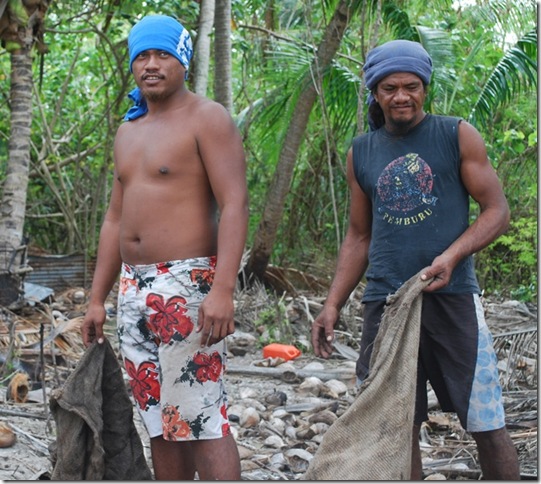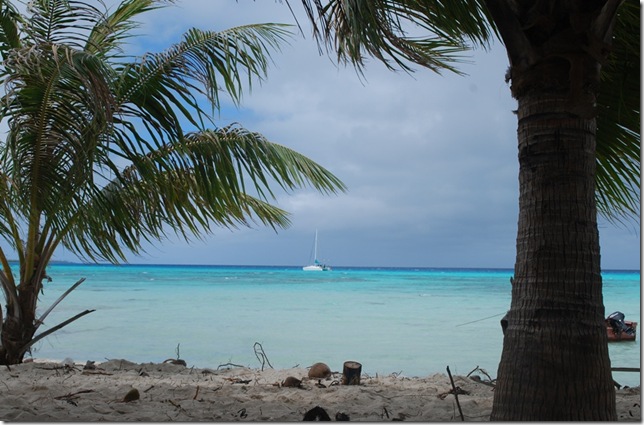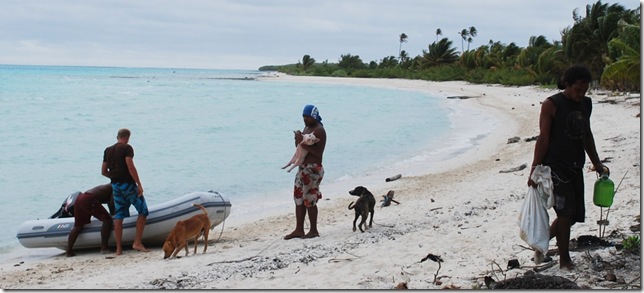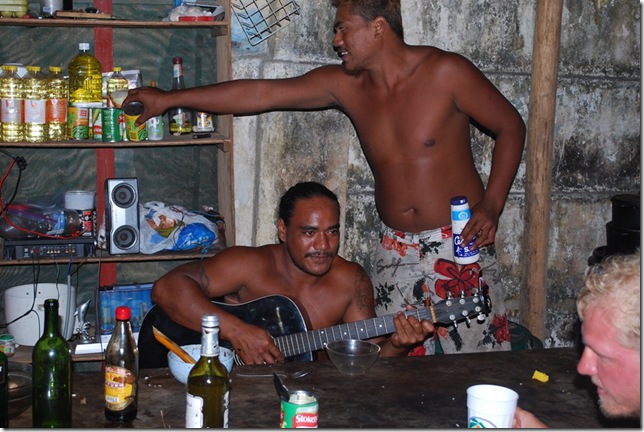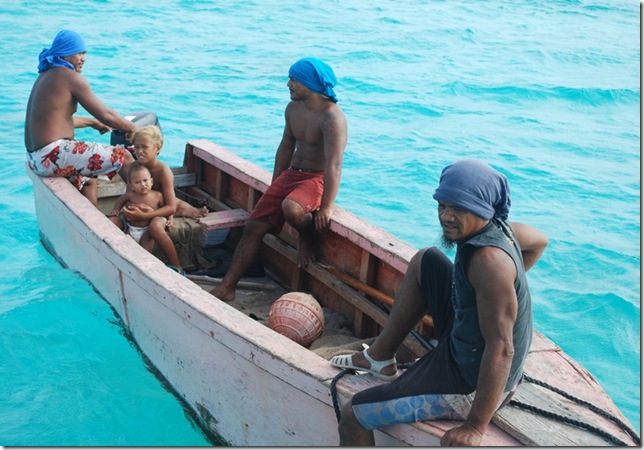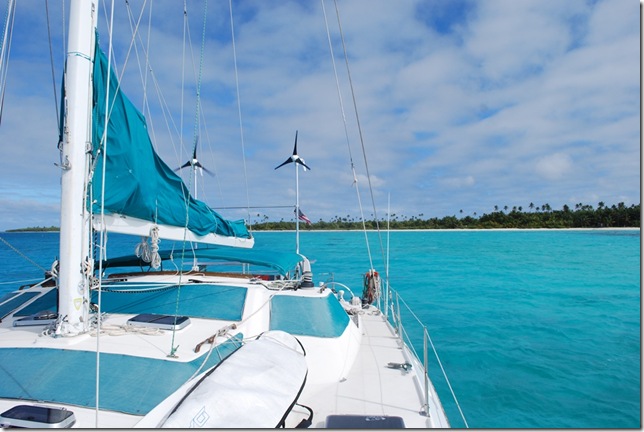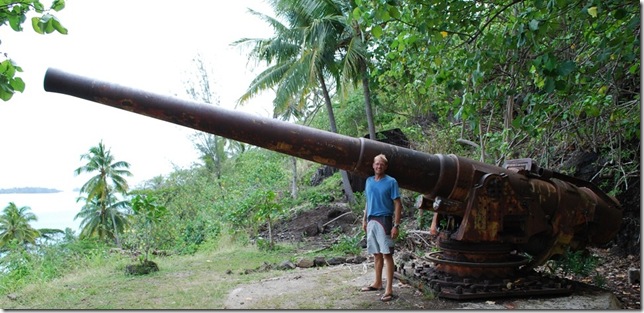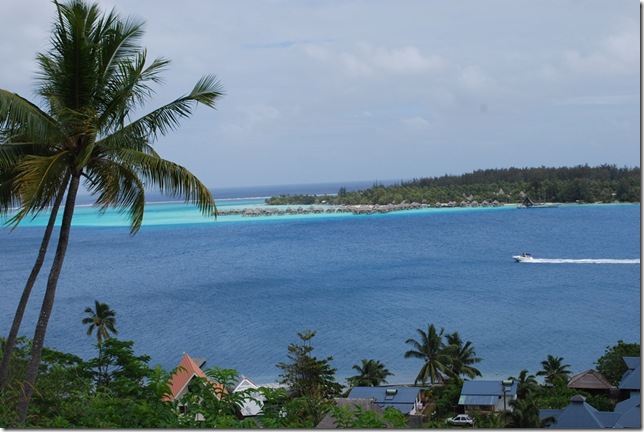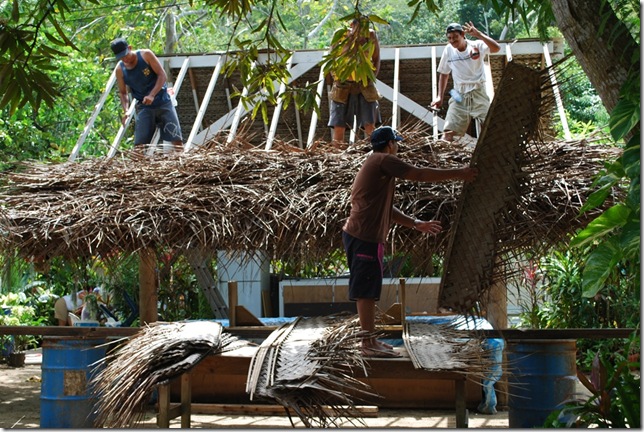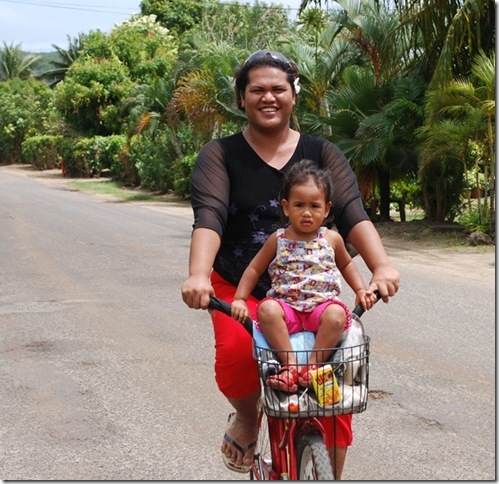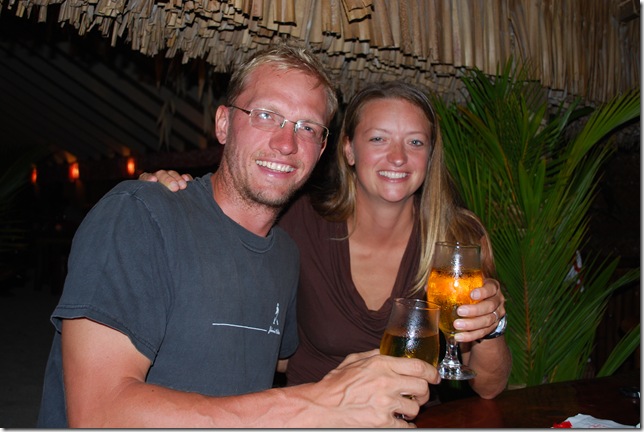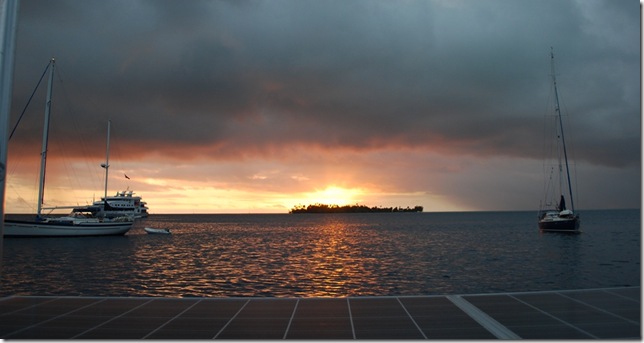Lat: 16 58.034′ S
Lon: 154 30.101′ W
We were awakened yesterday by shouts of “Hello, Bonjour!” I scrambled out to the cockpit and found the guys from the atoll approaching in their boat. They brought four lobsters and three small parrotfish for the second pack of cigarettes. They also asked about some cookies for the kids, but Lauren and I wanted to go ashore anyway, so we told them we’d be in later with some more things.
During breakfast, we downloaded a GRIB file and saw that things would be more pleasant for us offshore if we waited another day to leave, which was just fine with everyone after getting tossed around a bit on the way over.
Mopelia is obviously quite isolated and the mode of life simple, so we tried to pack a decent bag of stuff for them — a couple of shirts, a good pair of work gloves, candles, tea, candy and ribbons for the kids, canned corned beef, WD-40, and some fresh cookies Lauren had made. It’s really nice to be able to give things to people in places like this. When we got ashore, we found a couple of them working on copra by prying the meat from the coconuts. We made introductions and found that this part of the island was inhabited by Kalami (22), his wife Sophie, their two boys (one year and one month, respectively), Kalami’s male relatives Bako (33) and Ruta (25), and an 11-year old son of a friend. They offered us some “locale/Tahitian biere” (did I mention it was 10 a.m.?), which is a concoction they make from rain water, sugar, and yeast. It was very drinkable (tastes like a strong, slightly sweet white wine) and we sat down on a couple of burlap copra sacks to chat. The guys in their 20’s looked about as old as Lauren and I, and at 33, Bako would have passed for a grizzled 48 back in the states, but they were friendly and laid-back.
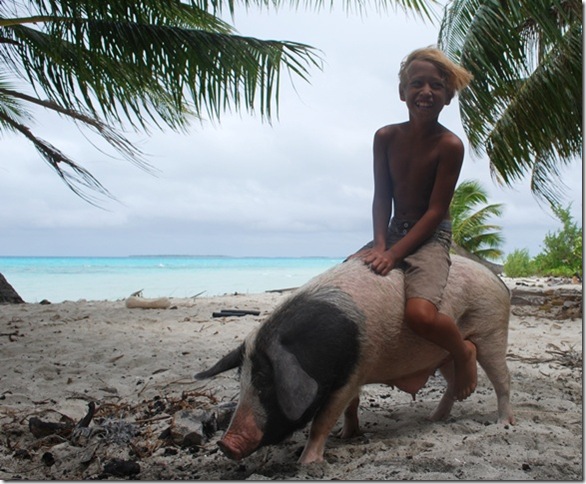 Yes, a pig does move along rather quickly when you reach back and slap it on the behind
Yes, a pig does move along rather quickly when you reach back and slap it on the behind
We were talking on the beach, looking out over the lagoon and at Pura Vida at anchor when it started to sprinkle and we all headed to the house. The house is sort of what you see on television when Sally Struthers is trying to get you to send money to save starving kids. Part of the building was old concrete, but the roof and places that had an outer wall were corrugated tin. There was only one partial inner wall made from a variety of materials that separated the area where Kalami and Sophie sleep. Interestingly enough, they have a couple of solar panels, a deep-cycle battery, and a couple of portable DVD players that also play music as well as an old amp and one above-dash automobile speaker. They were interested in having us burn some CDs for them (UB40, Bob Marley, Bon Jovi, etc.) and before too long they decided we should have a party that night.
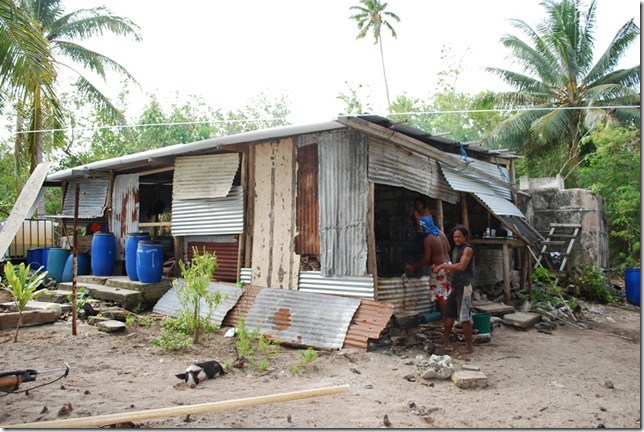 The casa (one of three on Mopelia)
The casa (one of three on Mopelia)
There was another boat anchored out on the reef, and the plan was to invite them to the party as well. The first step was go see Kalami’s Dad to pick up a small pig and some local beer for the party. Ruta and I drew pig and beer-fetching duty, and we headed out. I learned on the way that this meant a boat trip to the far south of the island. As they don’t have much fuel, we were to go in our dinghy. That was no problem, but the dinghy engine has slowly been losing power, and it wasn’t doing well at all. It turns out Kalami’s dad lives at the other end of the atoll, about 4 miles away, and we couldn’t get much above idle power. For some reason, you can rev the motor up, and the prop spins, but there’s no thrust. That’s not covered in the service manual’s two pages on troubleshooting, so it’s going to be a project. Anyway, we eventually decided to turn around and swap boats as we were getting nowhere, and I didn’t want to get stranded.
On the second attempt, we put Kalami’s engine on our dinghy, and we eventually made it. The boat that was anchored out on the reef turned out to be one of the boats we met in Bora Bora, and they were now anchored in the beautiful, peaceful area at the south of the atoll. Ashore, Ruta said hello to Kalami’s parents and set to work. Their place is almost too much to put into words, but imagine a stereotypical rural Appalachian or Arkansas one-room shack, all sorts of modern and primitive items strewn about the yard, a couple of large copra-drying racks, and numerous pigs, dogs, and ducks (first time to see them here). Now superimpose that on a beach and lagoon that Club Med would be drooling over if it wasn’t on an atoll in the middle nowhere. Kalami’s Dad was a chubby, amiable fellow with a big head of curly hair who wore a T-shirt and pair of briefs/speedos, which passes for casual wear on the atolls and takes a bit of getting used to. First, we grabbed a couple of pigs and tied them by the leg to a hammock near the beach. One was larger than the other, but both were small and white. We also grabbed a sort of grill to cook the pigs and Ruta filled the bottles we brought with the local beer. Kalami’s Dad makes the stuff in a big water barrel and also had some bananas in this batch. In typical island style, the bottles are any glass bottle or jug that’s been left or found, especially wine bottles. For corks, there’s a type of foam fishing buoy hanging from the re-bar protruding from the roof that can be cut and stuffed into the neck of the bottle.
We loaded the pigs, grill, and a pretty fair amount of the “locale biere” into the dinghy and finally arrived back several hours after we’d originally left. I’d inadvertently left Lauren there for several hours, but she managed well, getting to know the family. They receive a visit from about three trading boats a month from nearby Maupiti. They keep a number of pigs and there are also wild pigs on the island, so they trade pigs for cigarettes, baby food, and other commercial goods. They also get about 3 cruising boats a week during the season (an additional item we picked up at at Kalami’s father’s place was a guestbook filled with entries from visiting yachts). There’s essentially no money on the island, and they prefer the subsistence and trading existence to the monetary and labor economy. They have plenty of fish and meat, and grow a few vegetables as well. Lauren also learned how to make coconut milk, which has been something we’ve wanted to figure out. The key is to get a young coconut and the proper tool. They use a device that looks like a paddle with a scraper at the end of the handle. You sit on the fat part and use the scraper between your legs to clean the soft meat from a young coconut. The meat can then be wrung out using a cheesecloth to produce the milk that’s used for dishes like poisson cru.
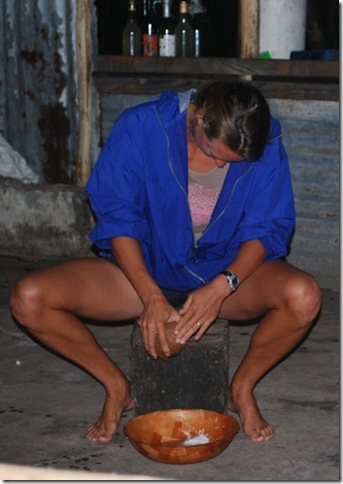 Lauren grating the meat out of a young coconut
Lauren grating the meat out of a young coconut
Dinner that night consisted of barbecued ribs, poisson cru, rice, and a second pork dish (I’m not sure which pig was ribs and which was stew, but Lauren says they were both good as long as someone else is doing the presto-change-o). For me, they even broke out a can of corn. Before we could get started eating, though, we had to make a quick run back to the boat for place settings for Lauren and I. As they were drinking from old wine bottles and bowls it doesn’t appear they have cups, and they didn’t have any extra plates or forks. No worries, as we’d forgotten my guitar as well.
After dinner the singing started. It turns out Ruta is an incredibly good guitar player even though he doesn’t own one and hasn’t touched one for 5 months. In addition to Tahitian and French songs, he played Bob Marley, Metallica, improvisations, and did some pretty impressive picking. Everybody joined in, and Ruta even got me to attempt some improvised vocals, which isn’t something you’ll be hearing anytime soon. There were songs about everything from my love / mon cherie to Jacque Chirac, to the moon and the pass, but Lauren and I almost died laughing when they all of a sudden started singing the French version of Hakuna Matata from the Lion King. Ruta was pretty impressed with the guitar and offered all the lobster in Mopelia for it. Unfortunately, I’m a vegetarian and we don’t have a freezer now, so we all had a good laugh at that being unfortunate for him. Because of the issues with our motor, Kalami and Bako took us back using their boat at the end of the night. The route is littered with shallow water and large coral heads, so we used a large light we had and left it with them to get back safely.
This morning, Kalami returned with the light and guestbook for us to sign (they hadn’t had a pen at the house the night before) and I gave him a few more things, including a low-power, guaranteed-for-life LED light that should help out a bit in the home lighting department. It seemed like we were both sad to say goodbye, but such is our life. The sun had come out and the wind had lightened up a bit, making our weather planning seem worthwhile. Tiff cooked up the lobsters and we enjoyed lunch before pulling up the anchor and motoring across the lagoon.
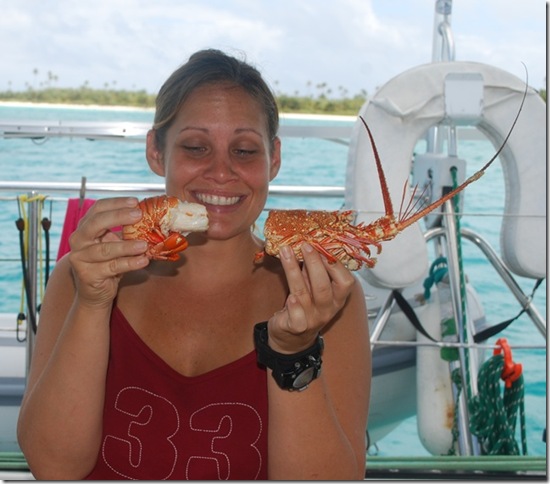 Et Voila! 1/4 of a pack of cigarettes worth of lobster
Et Voila! 1/4 of a pack of cigarettes worth of lobster
This place is so beautiful that we all just sat on deck and watched silently as we made our way toward the pass. Before we knew it, we were through the pass and out into open water. Tiff pulled down the French courtesy flag, and our visit in French Polynesia officially came to an end. It was a wonderful last stop and one that we’ll remember for a long time. Lauren looked through the guestbook and noticed that several boats had returned to Mopelia a second time after several years, and there’s no doubt we’d do the same if we came this way again.
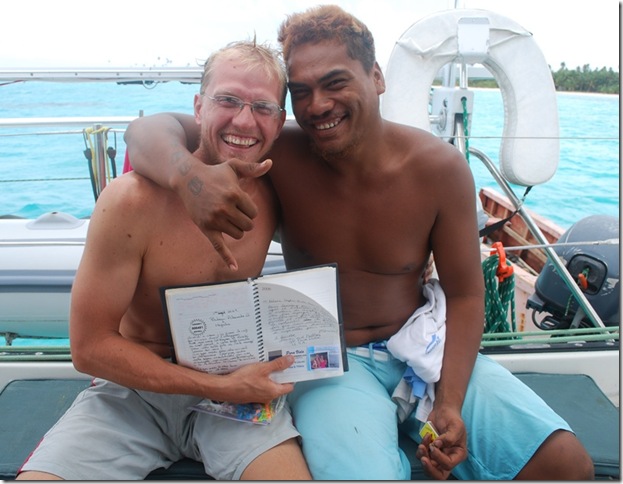 Our page in the Mopelia guestbook
Our page in the Mopelia guestbook
The seas are still up a bit, but not as bad as they were, and the sun is out, making it a beautiful day for sailing. We’re using just the jib again and are averaging above 5 knots with no problems.
Lat: 16 46.738′ S
Lon: 153 56.869′ W
Lauren and I started our last full day in Bora Bora with a snorkel trip to the “coral garden” around the point. I stayed at the surface on account of my ear, which has shown no improvement, but was able to enjoy things nonetheless. The coral wasn’t much to see, but there were a lot of colorful smaller fish that are evidently used to being fed, as many of them swarmed around us. There were also several schools of a light-colored fish that were laying in groups on the bottom, like they were having an afternoon nap. I’m still a little bummed about being diving-disabled in Bora Bora, but as Dr. Duval pointed out, I can’t complain too much, as there should be plenty of other dive opportunities.
Next we headed into town to do some shopping, including buying duty-free diesel, one of the few reasonably priced items to be found here. When we got to the fuel dock in the dinghy with our fuel jugs, we found a boat from the anchorage we’d just left along with a friend of theirs with a dinghy full of fuel jugs. The woman’s first question to Lauren was, “Does Dallas have the correct papers for the duty free fuel?” Evidently we’ve been fortunate in that even though the authorities in Papeete were feuding as I stood there, they managed to give me all the correct papers, unlike some other people we’ve meet. The other cruisers at the dock were missing one of the 4 papers that are required (the duty-free diesel permit alone isn’t enough), so I ended up using my papers to buy fuel for all of us.
Next we were off to the marine store to pick up a handheld VHF. One of ours was stolen from Lauren’s backpack in the Galapagos (where they retail for about $400) and our second one just died, which makes sharing a dinghy a little difficult. We also made the obligatory stop at the grocery store to stock up and grab some snacks and stopped at the hardware store for some boat project items.
Duty-free diesel is only about $3/gal, which feels like next to free, so the next morning, after topping off with water and emptying trash at the Bloody Mary’s dock, we headed back to the fuel dock to fill our jugs again, as all the diesel we’d bought the day before had been put into the tanks. This was our third visit to the gas station, and the woman who was a bit short and speaking French-only the first time we came and didn’t have enough cash was now very friendly, broke out reasonable English, and volunteered to combine our diesel purchases from the last couple of days so we didn’t have to do more paperwork. It really helps to smile and know how to say hello in the local language (“Yo-rana”). Our diesel tanks are now topped off and we have extra fuel in the jugs.
There are a couple of things I thought were interesting about Bora Bora that haven’t made it into a blog yet. One is that having reached the end of French Polynesia, we have yet to see a Polynesian wearing eyeglasses. We asked Moana about it in Ua Pou and he seemed to indicate that Polynesians had genetically good eyesight. I’ve mentioned it to another cruising couple and they couldn’t recall ever seeing a Polynesian with eyeglasses either. Another thing that seems to be unique to Bora Bora are go-fast boats with a complete disregard for anchored sailboats. The private boats and dive boats will buzz through an anchorage at a pretty high speed, sometimes within one boat length of anchored boats, which gets a little frustrating if you’re in the water working on the boat or in the middle of something that doesn’t like to be shaken up. Apparently because of all of the clear water and visible rocks and coral heads, the speedboats here have a unique design. Instead of sitting in the back of the boat, the driver sits on a seat in the bow of the boat and steers with a lever that moves left and right. Presumably, the forward helm station makes it easier to see the path that should be steered, but it’s the first time I’ve seen a design like that.
We weren’t the only boat that picked this window to leave. The VHF was crackling with boats hailing each other to check on conditions, arrange radio rendez-vous, and wish each other good trip. As we headed out the pass and set our sails, we could see at least five other boats heading out for different points west. Even in a gathering spot like Bora Bora, that feels like a virtual armada of cruising boats setting out.
We set a course for Mopelia, a small atoll we learned about from Jerome and Antoine while we were in Kauehi. It has the narrowest, supposedly most nerve-wracking pass in French Polynesia and is inhabited by between 3 and 20 people at a time.
The weather forecast called for moderate winds, followed by shifting light winds, before filling in from the southeast. Everything worked out as forecast, but we got a bit more wind and steep seas on the beam than we were expecting after things filled in during the early morning hours. Lauren did a good job on her watch of stowing all of the fuel and water jugs that had been sitting on the side decks and doing their best to jump overboard when things started getting rough. All of us pretty much stayed horizontal unless we had to get up, but nobody got sick enough to do any fish feeding. With her typical iron stomach, Lauren of course managed to do a bit of cooking (telling me later about picking the dead weevils out of the pasta) and some reading.
Between motoring in the light winds and doing 6 knots on just the jib when the wind picked up, we made the 128 nm run to Mopelia in time to attempt the pass at an ideal time, with the sun at our backs to make it easier to see and avoid coral heads. For the first time ever, our Navionics charts were off. When I lined up to head into the narrow, churning pass, the charts showed us going straight onto the reef, with the pass off to port. Oh well, this isn’t exactly a hotbed of yachting activity and you’ve got to trust your eyeballs, especially with a pass like this. The pass has quite a reputation, and it is narrow (maybe 60 ft or so and we have a beam of 21 ft), with lots of current (we got lucky and only had about 3-4 knots or so) and jagged coral rock edges, but it’s deep enough, and we made it through only a few tense minutes after we made the irreversible commitment to go for it. Lauren and Tiff each kept a look out for rocks from the bows and I kept busy with the throttles up and the wheel spinning back and forth as each refracted wave tried to turn the boat.
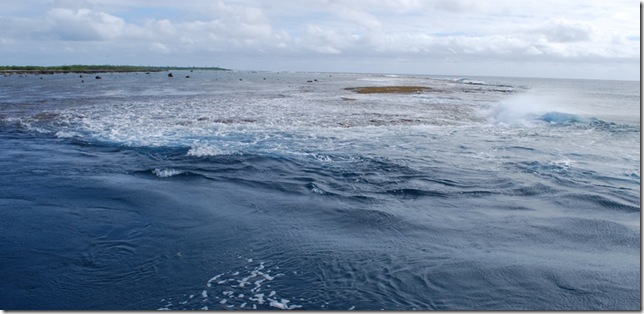 Current, rocks, and small breakers entering the pass
Current, rocks, and small breakers entering the pass
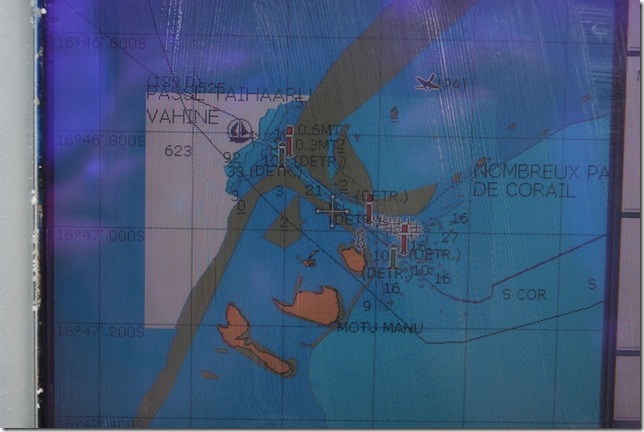 The bottom track shows the actual pass location
The bottom track shows the actual pass location
The atoll itself is incredibly beautiful. It is just a bit larger than 3 miles by 4 miles and sets NNW-SSE along the long axis. It has several motus, including a very large one that makes up the eastern side of the lagoon. A couple of the motus have small raised hills with greenery and coconut trees, while nice sandy beaches, and turquoise and soft blue water are everywhere. From our anchorage here on the northeast portion, we can see the spray thrown high up into the air as the swell crashes on the southern fringing reef 4 miles away. One of the motus is supposed to be a bird nesting site and the boat was surrounded by about a dozen large sea birds circling and swooping down near us as we approached the atoll.
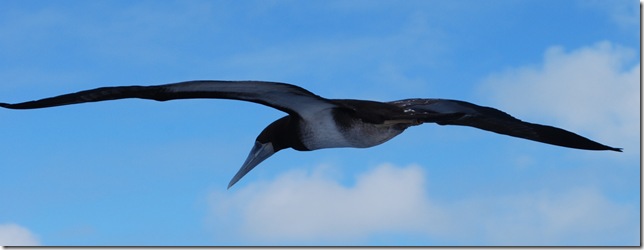 These guys were everywhere on the way in
These guys were everywhere on the way in
By the time we’d anchored and gotten settled, it was getting a bit close to dark for a shore visit, but we could see pigs wandering on the beach near a shack and home-built boat. Before long, a couple of guys got into the boat and headed our direction. They slowed near our stern and handed me two gutted, ready-to-eat parrotfish in a pan. The boat they came out on was a long and narrow home-built work boat with an outboard motor. Mounted on the bow was a nice sailing winch that they’d salvaged from a catamaran that is apparently wrecked on the reef near the pass. We’d heard that supply ships are pretty scarce here and that cigarettes are highly valued. Although none of us are smokers, Lauren and I had picked up a couple of packs before leaving Bora Bora. You should have heard the yelling and hollering that broke out when I told them we had cigarettes to trade for the fish. It was like they’d won the lottery. Tomorrow morning they’re bringing out lobster for the second pack. We asked how many people lived on the island, and they said two families. When we asked how many people that included, there was some finger-counting, a sort of confused look, and then we moved onto the next question.
Tiff did a great job preparing and cooking the fish, and we incorporated it into a fish burrito dinner that Wahoo’s would be proud of. There’s only one light on the island, barely visible for a couple of hours after sunset, coming from the dwelling on the beach that we saw earlier today. Other than that, it’s an overcast night and it would be hard to tell we were anchored all alone in a lagoon at all just by looking around.
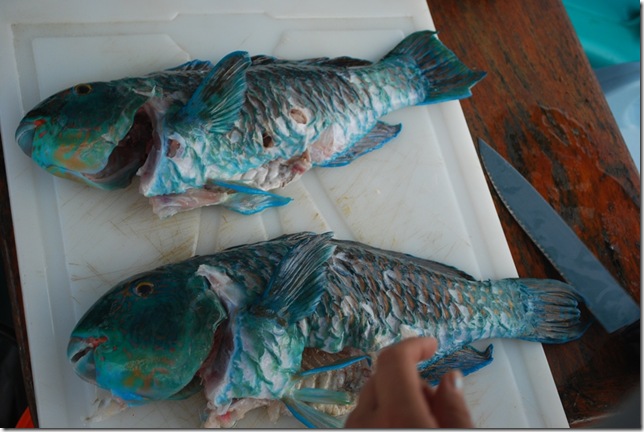 Parrot fish (in addition to the colors, the mouths really are like beaks)
Parrot fish (in addition to the colors, the mouths really are like beaks)
We’re probably headed out tomorrow to try to get to Aitutaki by the weekend, but this is definitely one of those virtually untouched places where it’s easy to linger and just take in the peace and natural beauty.
Yesterday morning Tiff and I went scuba diving a mere few hundred feet or so from where the boat was anchored. We had seen multiple dive boats in a particular spot tied to a moored dive boat, so we assumed that there must be something there to see. Despite that it was close by, getting over there was a comedy of errors. The current was intense and rapidly carried Tiff and I away from the boat, in the opposite direction of the dive site. We agreed that it would be best to get a lift over in the dinghy rather than trying to swim there, but even at the lowest possible speed, riding alongside the dinghy was a bit of a nightmare what with water flowing over our heads so that we couldn’t see or breathe, so I had to stop being stubborn and allow Dallas to drag me and my 40 lb gear into the dinghy for the 2 minute ride. Then as he was pulling Tiff into the dinghy, I lost my balance and fell back into the water and had to repeat the process. Needless, to say, Dallas got more exercise than he anticipated when he volunteered to give us a lift.
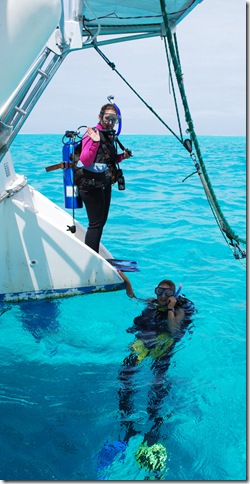 Check out the clarity of the water!
Check out the clarity of the water!
Once at the dive site, we quickly sank to the shallow bottom (around 12′) and found ourselves drifting back toward the boat super fast. We had to kick like mad to stay near the coral heads, but we must not be the only ones who have had trouble with this, as we found ropes tied between the coral heads to grab onto. These kept us from immediately floating back to the boat and thus having a very short dive. We held the ropes as we explored four large coral heads and the surrounding fish. The most common ones seemed to be zebra fish, needle fish, schools of small vibrantly blue ones, and black, white, and yellow angelfish.
Dallas had suspected that this was one of the sites where sharks or rays are fed for the tourists, who use long hoses attached to a small tanks of compressed air that remains on the boat to breathe underwater. While we didn’t see any tourist boats arrive while we were at the site, we are pretty sure that Dallas was correct, as we had two very large (about 4′ across) gray stingrays circling around us for at least 10 minutes as if we were supposed to feed them! Under other circumstances, both of us agreed that we would have been pretty freaked out by this, but it helped that we had heard about the feedings and the rays’ apparent comfort with people. Even so, we didn’t expect them to get SO close, and when one of them approached Tiff almost seeming to want to kiss her (it was only a few inches from her face), I instinctively grabbed her and pulled her away! She later said that her instinct was to freeze up and pretend she wasn’t there!
After about half an hour, we had seen what we wanted to see (and I was low on air, as I was using what remained from Dallas’ dive on our anchor in Huahine), so we rose to the surface. We blew our whistles to get Dallas’ attention, but the boat was upwind of us, so that didn’t work. Dallas had said he would be checking for us every five minutes, but Tiff and I decided to use the formidable current to help propel us back to the boat. About two minutes later, we were there!
We talked over our plans for the day and decided to try to motor over to a nearby anchorage. Dallas and I used the dinghy and depth sounder to confirm that we could make it there without running aground on one of the many coral heads. While it was very shallow (as little as 6′) in some places, it looked like we would be fine with our 3.5′ draft, and we were. We were surprised to see some monohulls in the anchorage, though.
A French woman from one of the monohulls came by and invited us to her 4-year-old daughter’s birthday party on the beach. She was a little disappointed that we didn’t have children to attend the party, but she later found some local kids on the beach to invite. Tiff and I decided to go, and we really enjoyed the company of the small group of cruisers in attendance from France, New Zealand, Columbia, and Switzerland. We drank some rum, played with the bilingual kids ("will you play avec me?"), and I even had the opportunity to play "Happy Birthday" on the Swiss mountain horn. It seemed that a good time was had by all until the end of the night when we were reminded how difficult it can be to sustain positive relationships on the close quarters of one’s boat. One couple had a very public but controlled argument before heading back to their boat, while another got into a loud, intensely emotional fight back on their boat. We were anchored some distance away, but we could clearly hear what was going on, and it was all I could do not to jump in the dinghy and try to calm them (particularly the woman) down. Just when we thought the situation had subsided, we heard a splash and realized that the woman was in the water swimming toward shore with the man following behind in the dinghy, trying in vain to get her aboard. At this point Dallas agreed that it was time to intervene, and we picked up the woman in our dinghy and housed her for the night (after Dallas retrieved some dry clothes from her boat and had a good chat with the man). The next morning she was gone, and we haven’t heard anything since, so we are assuming it was just a case of too much booze. After spending time in less inhabited, very tranquil anchorages, we are not used to such drama!
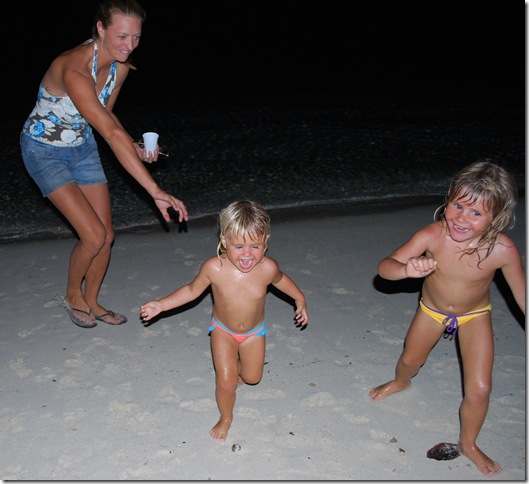 Chasing the birthday girl and her sister
Chasing the birthday girl and her sister
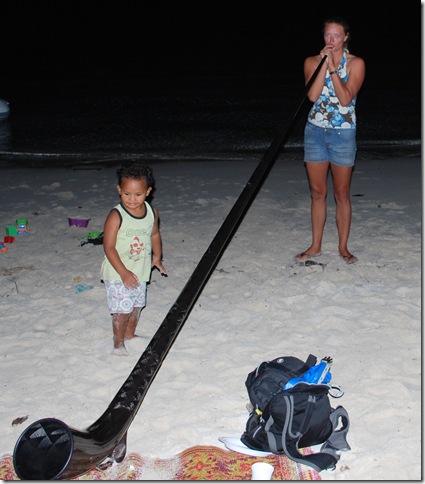 Pulling out the collapsible Swiss mountain horn was a great party trick
Pulling out the collapsible Swiss mountain horn was a great party trick
Yesterday was much less dramatic. Wes and Tiff took the dinghy to go snorkeling, Dallas did some boat work (sewing a tear on the spinnaker, repairing a broken starter rope for the outboard engine), I baked some banana bread and went snorkeling around the anchorage, and we Skyped with friends and family.
Last night Dallas and I had dinner at "Ben’s", a "snack" (small, informal restaurant) on the road that runs along the beach. Ben is from Bora Bora while his wife is from…wait for it…Oklahoma! They have been running the snack for 20 years and have a lot of insight into the island and its social problems. It sounds like Bora Bora is anything but paradise for the locals. For example, there are few jobs beyond those in the tourist industry. The best of these go to the French, and the mid-level jobs go to Tahitians and other islanders, leaving only 15% of the jobs (the menial ones) for natives of Bora Bora. To top it off, public service companies such as the electric company have a monopoly and are increasing their rates just as the island has fallen into an economic crisis. As happens anywhere, these economic problems coincide with mental health problems, and Ben and Robin are currently in the process of adopting a boy with an alcoholic father and a remarried, negligent mother whose elderly foster mother physically abused him. These were harsh realities to consider, but it was enlightening to get the local perspective of the island, as this was our first opportunity to do so in the Society Islands (in English as well!). Incidentally, we also learned that Marlon Brando’s wife, who he met during the filming of Mutiny on the Bounty in Tahiti, had no teeth until she was given a new set by MGM Studios! Unfortunately, Marlon’s outrageous fortune did not prevent them from having outrageous problems, and for those who don’t know, his son was later imprisoned for murdering the abusive boyfriend of his sister, who later committed suicide. Talk about drama!
After all of this, we are feeling ready to get back to the peace and quiet of the sea. Today we will get duty-free diesel, do some last minute snorkeling, and prepare to get underway tomorrow.
We’ve decided to see some other parts of the island, so yesterday Lauren and I went ashore to get the bicycles and check out with the Yacht Club. Before heading back to the boat, we took a bike ride to see one of the WWII-era shore gun installations that was left by the US. We biked a few miles to a point of land on the northwest part of the island and then climbed up a short but very steep road to where one of the guns was mounted. There are a pair of 7-inch gun installations, although one of the guns is missing. Beside the gun that’s still there was an ammunition hut, and a bit higher on the hill was a small pillbox, apparently for spotters. The support for the gun still has a very legible stamp from Bethlehem Steel, dated 1906.
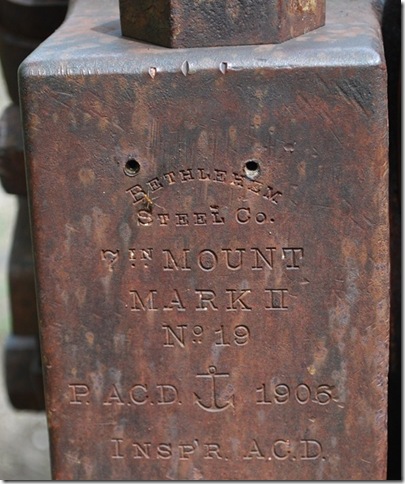 Yeah, OK. But there are engineers that read this too.
Yeah, OK. But there are engineers that read this too.
The ride to and from the gun is like a long ride at the edge of town, not completely rural, but different than the local version of the urban scene. There were a few interesting sites. One was a thatched roof under construction. It’s build by nailing woven coconut panels onto a wooden frame. Many of the houses we passed had a another unique feature as well – graves in the front yard. Some were like little shrines, but most were fairly simple affairs constructed of outdoor tiles, sometimes no more than 10 feet from the front door. I guess ancestors are still revered here, even if it’s no longer the basis of a religion.
After returning to the boat, we headed south to anchor off of Point Te Raiiti, which is near the well-know American restaurant Bloody Mary’s. Lauren and I were planning to either try to see a fire-dancing show at the nearby Hotel Bora Bora or have dinner at Bloody Mary’s, so at sunset we took the dinghy over to the hotel to see if there was a show. Not only was there no show, but Hotel Bora Bora, the oldest hotel on the island, is not open and in a state of disrepair/construction (apparently they’re looking for buyers).
That left us with Bloody Mary’s, so we dinghied over and tied up to their dock. In typical American style, they have two big celebrity boards outside the restaurant where the names of visiting celebrities are painted. It doesn’t look like it’s been updated in a while, but they’ve definitely seen their share of big name entertainment, sports, art, and political stars through the years. Inside, the floor is covered with sand, and they have a shoe/sandal check. We didn’t need to be asked. You’ve got to love a fine-dining restaurant where you can show up in flip-flops and then self-check them behind the desk. We showed up not too long after the restaurant opened and just had beers at the bar while the hotel busses came in one at a time, dropping off their guests for dinner. Although there were Brazilian and Japanese tourists, the majority of the patrons seemed to be well-off American newlyweds on their honeymoon.
To put this in context, imagine large diamond rings, lots of makeup, "I’m on my honeymoon" dresses, cameras, and the latest US and international fashion. Then there’s me and Lauren. Lauren went nearly all-out. She had put on a nice T-shirt with a collar that makes it look not so much like a T-shirt and jean capris instead of shorts. She also spent a fair amount of time brushing her hair (which looked great) while I was getting the dinghy ready. There’s no better than about a one in four chance of catching me in a pair of shorts that meet the stateside definition of "clean", and yesterday wasn’t one of those days. I added a black "going ashore" T-shirt that didn’t clash too badly and we were off. All of the American guys had nice short haircuts and were clean-shaven. Lauren gave me a haircut a couple of days ago, but I hadn’t bothered to even see what my hair looked like before heading out. As for shaving, I’m not sure when I did that last, but it feels like it was maybe two weeks. At any rate, we felt comfortable and at home, although a bit more like locals or ex-pats than tourists. We struck up conversations with several American couples that were waiting for tables, including two very nice honeymooning lawyers from New York, Matt & Farrin. Joe, who’s been here since 1978, and his brother run the place, and we also had a chance to visit with Joe for a while. Several of the moorings he’s put out for the boats of restaurant patrons have been damaged, and we may use the dinghy, GPS, and dive tanks to help him find a few of them today or tomorrow. We also joked with Joe about the missing flies. There is a fair amount of fresh fish laid out in the restaurant (see below), and unlike the dockside areas where fresh fish are sold, there was a conspicuous absence of flies. Joe related that it takes a fair amount of work to keep the place fly-free, and when it gets more humid here during the upcoming summer it will be a bit more difficult. His efforts are especially impressive when the lack of traditional walls, windows, air-conditioning, etc. in the restaurant are taken into account.
The dinner menu at Bloody Mary’s is an ice table where the various catches of the day are filleted and available for selection. Joe’s brother talks through the various selections of fish varieties, lobster, shrimp, steak, and chicken and then goes over prices. You make a decision on which piece you’d like then head to your table. Lauren got the chef’s special Mahi Mahi, and I got the vegetarian plate. Both were excellent. Lauren’s was so good that even though the fluffy white pet cat ended up hanging out by our table for a while, Lauren refused to share. (The cat was obviously well-cared for, so despite Lauren’s soft spot for cats, it wasn’t going to get it any $35/plate chef’s special Mahi Mahi).
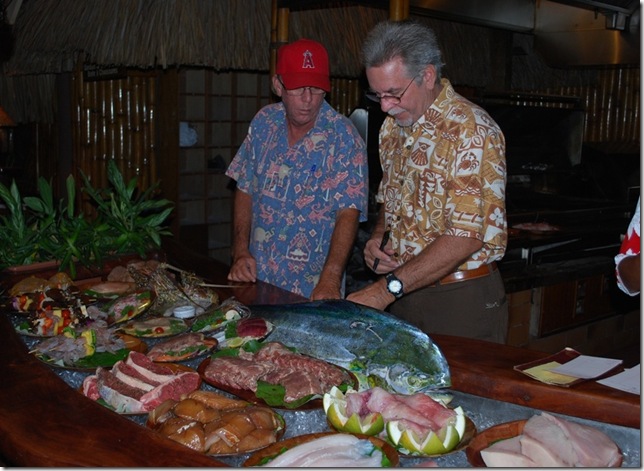 Joe (left) and his brother explain the menu
Joe (left) and his brother explain the menu
We met up with Matt & Farrin at the bar after dinner, and they passed up the last bus to take the brave adventure of joining us for drinks on the boat and a dinghy ride back to their hotel. It was fun to visit with some Americans our age, and hopefully they enjoyed the chance to check out something a little less touristy. The dinghy ride back to their bungalow was a bit of an adventure as it was a cloudy night, and the route passes through the one part of the lagoon that’s too shallow to navigate by sailboat. Lauren and Matt sat in the front and used a bright light to see and direct me around the coral heads until we were eventually able to beach the dinghy at the hotel. By chance, on the way back we found the small unlit or unmarked channels we should have been using, and things were a bit easier.
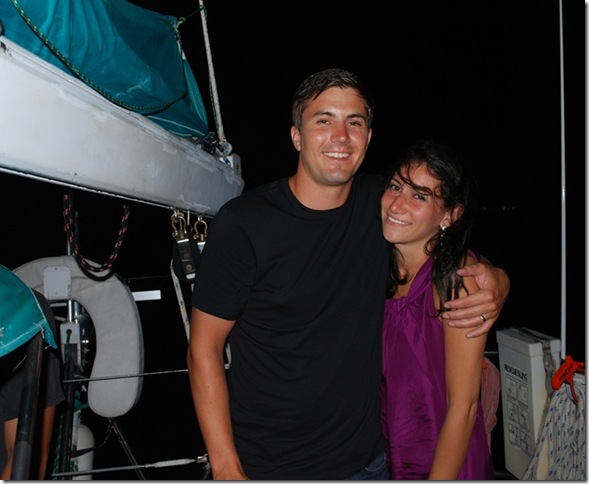 Matt & Farrin on their post-dinner private yacht excursion
Matt & Farrin on their post-dinner private yacht excursion
Today Lauren and Tiff are off to dive a shallow site only a few hundred feet away that boats seem to be visiting several times a day.
Today was a day of doing errands in the island way. First, we went to check in at the Yacht Club. We’ve been tied up to a mooring since Saturday morning, but we finally made it over to check in today. We were getting back in the dinghy to leave because the office wasn’t open yet when Paul, the bartender and only waiter from the night before, caught up with us at the dinghy dock. He works every day, and in addition to being the bartender and waiter, he also handles check-in.
Then it was off to buy gasoline for the dinghy and compressor and try to get two of our propane tanks filled. At more than $6.25/gallon, buying gas is always a painful experience, but this time we had even more fun, as the station doesn’t take credit cards and we didn’t have enough cash. Lauren waited while I walked to the bank and withdrew enough money to cover our gas bill. We left the Galapagos with 3 nearly full propane tanks, and we just started using our 3rd one the other day. The station also supplies propane, but with a bit of a twist as well. They’re out of propane until Wednesday, when they will sell us a canister of the local type, but they can’t fill our American-style propane canisters. If we can find or build an adapter, we can do the transfer on our own, but finding an adapter is probably not going to be a trivial task. I brought along an extra hose to build an adapter, so if we can find a local hose to purchase, we my be able to get things done, expensive as it may be.
After that good news, it was time to visit the gendarme to do our check-out. They’re OK with you hanging around for a few days after checking out, so I wanted to get things taken care of first thing Monday morning. The gendarme that helped us was clearly new to the job. He didn’t seem extremely certain of the proper paperwork and double-checked all the passport numbers, birthdates, etc. In Latin America, that’s expected, but the French authorities are typically much less interested in the details. He was also responsible for answering the telephone, which for some completely unimaginable reason rang about every 45 seconds. Six forms and a fair amount of time later, we were off to the bank to collect our bond.
Bank Socredo was so backed up (this is not uncommon) that there were numerous people waiting in the parking lot, as all of the seats in the bank were full. They were serving number 63 and we drew number 102. With only about an hour before the 11:30 lunchtime shutdown, I was afraid we may have to return after lunch, but we sat down on the floor and started waiting. We’d brought a magazine to read to kill time (don’t you plan on that when you go to the bank?), I took a trip to the marine store, and then Lauren went grocery shopping. With only about 2 minutes to go before closing, they called my number (numerous people had tired of waiting and left) and the bond processing got underway. Dragon had experienced some problems with the bank not liking the paperwork from the gendarme, and I really didn’t want to start making trips back and forth between them and waiting in long lines. When the teller explained that she needed a stamp from the gendarme on a particular document, I was ready. "No problem," I said, "I’ve been to the gendarme and have the stamp right here" (on a completely unrelated document). She seemed a little unsure but agreed that everything was fine, and we continued. About 45 minutes later, I walked out with our $5000+ bond returned in the form of $2000 dollars worth of American Express travelers checks (could you please sign all 40 now) and $3000+ in Polynesian francs. The bank was out of New Zealand and US dollars and weren’t sure when they’d be getting more.
Back on the boat we had lunch and Lauren took me up the stick to replace the worn shackle for the spinnaker halyard block, which went very smoothly. Then it was time to head back into town to try out the medical establishment in French Polynesia. Ever since free diving to untangle the anchor in Papeete, I haven’t been able to hear much out of my left ear and its been ringing the whole time. Our first attempt to get directions to the public health clinic landed us at the pharmacy, where the woman on the other side of the counter explained that public health services weren’t for us since we were tourists, and we’d need to go to a private doctor. I thought the public clinic was worth a shot, but there was a private doctor two doors down, so we took a number (written in marker on purple construction paper) and sat down in the outdoor waiting room. In about 45 minutes our turn came, and Lauren and I went in. The doctor was a very kind and good-natured man who spoke English pretty well, and I explained the problem. After a couple of questions he had a look in my ear and said that although I’d come close to rupturing the eardrum, it was simply inflamed with fluid inside the eardrum. After experiencing significant hearing loss for a couple of weeks, I was pretty relieved to learn that the problem was only temporary. After completing the diagnosis, it was time to fill out paperwork. He pushed a blank piece of paper across the desk and asked me to write down my name, date of birth, and the name of the boat. That was it; paperwork complete. He chatted with us while he typed my information and prescription into the computer. It turns out he sailed here from France 23 years ago with his 6 and 8 year old sons. He was planning to circumnavigate as well, but once he got to Bora Bora he never left. We thanked him, gave him a 5000 CFP note (about $59) for the payment fee in cash and left for the pharmacy. His prescription for three types of pills and eardrops came to about $90, but it will be worth it if I can hear again in a week as he claims.
Not long after we returned to the boat, we enjoyed another beautiful sunset, watching the sun dip over the motu at the north edge of the pass.
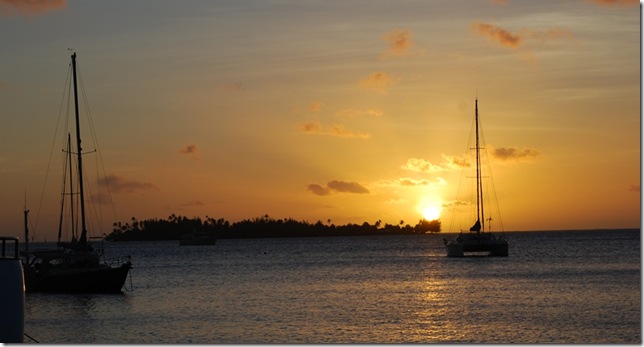 Sunset yesterday from the Bora Bora Yacht Club dock
Sunset yesterday from the Bora Bora Yacht Club dock
Someone asked me the other day why Bora Bora is so well known, and there seem to be a at least a couple of reasons. One is its natural beauty, which is widely acclaimed. The natural beauty comes from three things: the picturesque, rugged peaks, the clear lagoon, and the fringing motus. There are three peaks, and all are rugged and beautiful, offering a changing skyline as you travel around the island. The mountains of the other islands are larger and they have peaks that are just as beautiful, but Bora Bora is like a small "best-of" island where only the prettiest of the mountains of the other islands are present. The lagoon is incredibly clear (I could easily see our anchor chain on the bottom in 40 feet of water at 7:30 am, with the sun still low in the sky). Surprisingly, although the colors of the lagoons are beautiful everywhere we stopped in the Tuamotus and Society islands, Bora Bora is by far the clearest we’ve seen. Antoine said that the lagoons of some atolls in the Tuamotus are clear and others aren’t. I don’t know why the lagoon here is so clear, but it’s pretty amazing for diving and snorkeling and makes the colors of the lagoon all the more spectacular in the sunlight. Instead of a fringing reef, Bora Bora has many motus along the edge of the lagoon that provide idyllic sandy beaches and a taste of atoll geography. Many of the high-end bungalow-over-the-water hotels are on isolated motus. The US presence here during WWII also seems to have played a key role. In addition to familiarizing people in the US with the name of the island, the airstrip that was left behind was the main airport for French Polynesia for almost 20 years, ensuring that Bora Bora would become a feasible tourist destination.
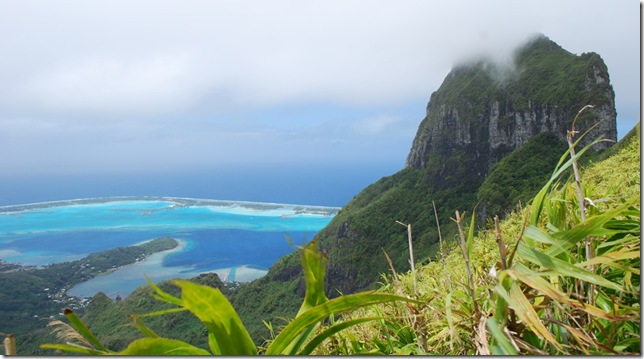 Another view from near the top of the mountain
Another view from near the top of the mountain
The main town of Vaitape isn’t much to see. It is built on a fairly wide area of the coastal plain, in the style of the Society Island towns — most businesses are strung along the main road around the island, and houses are built between the main road and the mountains. As a tourist destination, the town is pretty dismal. It’s not attractive at all and is half-comprised of the shops that fill the districts where cruise ship passengers disembark. The real pleasure in Bora Bora is in the high-end hotels, sandy beaches, beautiful waters of the lagoon, and natural beauty of the mountains.


